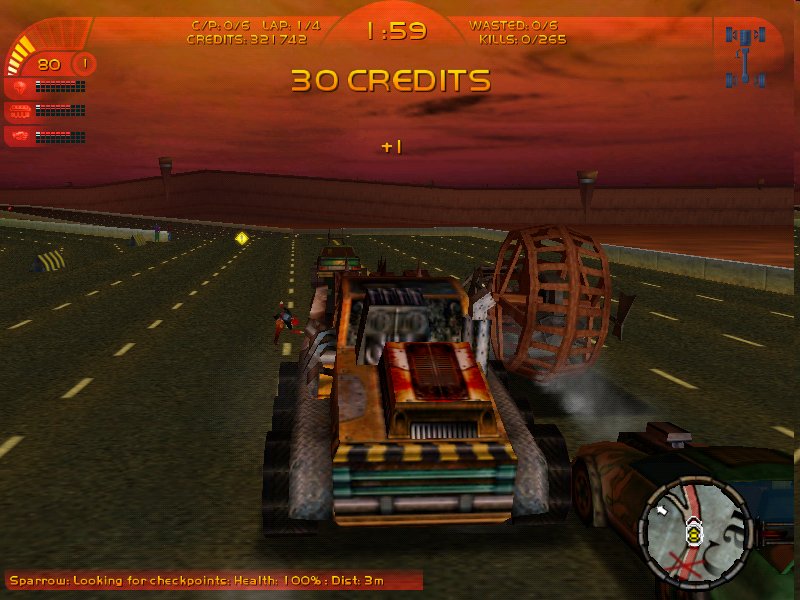
Carmageddon: TDR 2000
Written by: Rik
Date posted: October 14, 2008
- Genre: Action
- Developed by: Torus Games
- Published by: Sales Curve Interactive
- Year released: 2000
- Our score: 4
Regular readers may have noticed that when it comes to comprehensive coverage of a series of games, we’re perhaps not your safest bet. Sure, we’ve bought the King’s Quest Collection, but getting round to playing the games, well, that’s another matter entirely. This year we managed to finally get the venerable Monkey Island series covered, but on the other hand it was a project that spanned around six years and involved the games themselves being reviewed in no particular order. It’s not something we’re especially proud of, so in a bid to right the wrongs of the past, it’s a pleasure to present this review, of the final chapter of the Carmageddon saga (no, no, you’re welcome, really).
While we may knock sequels, data discs and annual updates, in many ways they give us what we want. With so much dross around, why should we complain if a developer, having stumbled upon a successful formula, chooses to knock out a couple of follow-ups – after all, we enjoyed the original, the story will be slightly different, there might be some cool new features, the graphics will be slightly better – it’ll more than pass the time. And, yes, we might moan about the annual FIFA or Pro Evolution update, but we still shell out for ’em – we don’t want to be stuck with last year’s teams, and, what, there’s a new way to pirouette past defenders, you say? Sold.
Carmageddon, though, is not FIFA. We don’t need a new one each year, or even every couple of years. Though the original game was a mildly novel title which garnered some deserved praise on release, it was, and remains, a game about ploughing your car through as many pedestrians as possible. Despite what the tabloid press may think of the gaming community, Carmageddon was never likely to become a genre in itself, with bloodthirsty teenagers gathering outside their local branch of GAME to purchase the latest and best ‘auto-murder’ title, happy to accept a smattering of graphical improvements and a handful of new features in exchange for their £30.
All of which renders TDR 2000‘s existence rather redundant. Yes, it looks slightly better than Carmageddon 2, the handling not as ‘slidey’, and the AI drivers generally behave a little less moronically than before, but underneath it all it’s still pretty much the same game. The main innovation is the attempt at a story, which I thought (logically enough in my opinion) might have something to do with the film Death Race 2000 (‘TDR 2000’ – see?) starring a young Sly Stallone and recently remade with lovable bonehead Jason Statham in the lead role.
It doesn’t though, and in true Carmageddon tradition it fails to provide much in the way of meaningful justification or context for all of the on-screen carnage. During the pre-rendered intro, an Australian attempting an American accent drawls on about new cities being built for the affluent to live in while the old ones containing the poor and the downtrodden are bombarded with nuclear weapons. The radiation drives the remaining inhabitants insane (funny, I thought it would have killed them myself) and creates a violent futuristic nightmare that no-one can escape from…until NOW!
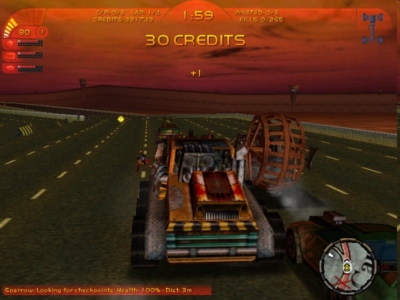
You can opt for a vehicle other than the standard red coupe, like this violent-looking combine-harvester thingy.
If all of that sounds like a load of old bollocks to you, then you’re not alone. Essentially the point seems to be that you’re trying to find a way out of each level, and, ultimately, out of the scummy radioactive wasteland and into the nice clean new utopia. In game terms this means that roughly half the action is based upon the familiar template of racing, running people over and smashing into opponents, and the other half focuses on plotting your escape by carrying out ‘missions’ of the usual ‘go here, do this’ variety.
We’d already had mission levels in Carmageddon 2, of course, and my considered opinion was what they were a bit crap. In TDR 2000, they’re just as annoying and a lot more regular. Possibly the most irritating part about these sections of the game is that you aren’t really sure what you’re being asked to do and why – you just finish a regular race, click the menu button to go onto the next one, and then some green text flashes up saying something like, “The next thing you have to do is blow up the power plant, but you’ll only have one minute to do it or else you’re dead, asshole!” But why, why, why?
An early example sees you tasked with lurking at the side of a man-made lake, lobbing mines at a fake shark in an attempt to destroy it. As gaming moments go, this is right down there with some of the worst, with the sheer pointlessness of it all compounded by the difficulties encountered in actually completing the mission successfully. Apparently, it was all part of the escape plan, which eventually involved me setting a giant animatronic gorilla on the loose in order for it to smash a pathway to freedom (much to my bemusement).
Of course, there’s nothing wrong with the whole ‘go to point A, go to point B, time limit is X’ gameplay mechanic, but by relying on it so heavily, TDR 2000 positions itself alongside titles that, frankly, do it so much better. Fire up GTA, Midtown Madness 2 or even Driver for that matter, and not only will things seem a whole lot more sensible and grown-up than the zany antics on offer here, it’ll be a hell of a lot more interesting too.
You see, for all of TDR2000‘s blood, guts and swearing (not to mention some of the most deliberately obnoxious techno music ever committed to a game soundtrack), playing it is actually quite dull. The high points come when the game retreads familiar ground, but even the non-mission races aren’t quite right, offering scant reward for creating carnage and forcing you to rely on finding time bonuses or passing through the next checkpoint to stay in the game.
While the original may have been one-dimensional, tinkering with the formula in an attempt to give it some longevity has ultimately diluted the anarchic energy the series once possessed to leave us with this, a game in which smashing into pedestrians and other cars is actually too boring to persist with. Now that’s quite an achievement.

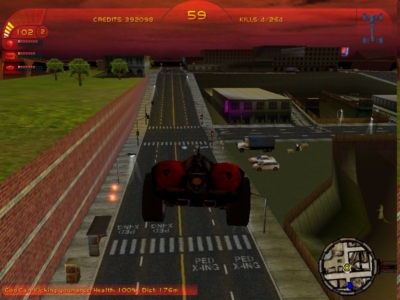
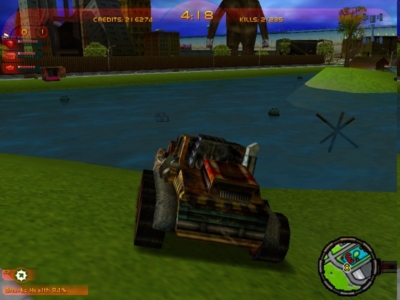
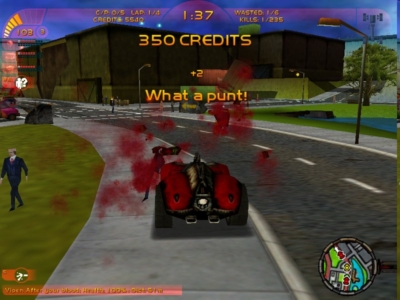

 Posts
Posts